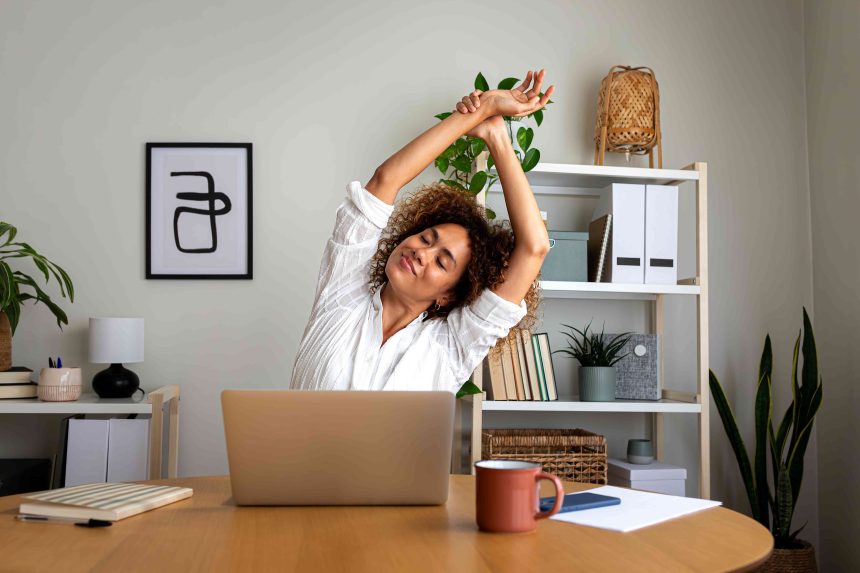Even if you love your job, sitting down and working at a desk all day can be draining—it’s easy to lose the motivation to move your body. But certain strategies may be able to help you make movement at work a habit, experts said.
Most people know that spending the majority of their day seated isn’t the healthiest practice. According to a new study published in the Journal of the American College of Cardiology, sedentary behavior is associated with future adverse cardiovascular outcomes, including death from heart failure.
This study adds to a large body of research indicating that extended periods of sitting can negatively impact a person’s health, including increasing the risk of cardiovascular disease, cancer, and diabetes. Prolonged sitting has also been linked to exhaustion, decreased job satisfaction, and aches and pains in office workers.
Fortunately, there’s also mounting evidence that taking movement breaks throughout the day—even brief ones—can help counteract the effects of all that sitting.
“Regular movement breaks throughout the day are essential for physical and mental health,” Malasri Chaudhery-Malgeri, PhD, clinical psychologist and chief clinical officer at Recovery.com, told Health. “By building small, intentional habits—like timed breaks or leaning on accountability—we can transform a desk job into an opportunity for wellness and renewed focus.”
While that’s great news, actually finding the time and energy to take those movement breaks—especially when you’re focused on work—is easier said than done.
So, how can you force yourself to get up and move while you’re working? Here are the four strategies experts recommended.
For most office workers, it isn’t feasible to take long breaks away from their desks to work out. Instead, try taking five-minute movement breaks every hour, said Shelly Qualtieri, RSW, a registered social worker based in Calgary.
In fact, just five minutes of activity every hour has been shown to reduce cardiometabolic risks, improve focus, and combat other negative effects of inactivity.
Remembering to take these short, frequent breaks can be tricky without a reminder, though. So set a timer or use an app such as Pomodoro or Focus To-Do, which reminds you to pause after 55 minutes of work, Qualtieri told Health.
“When the timer sounds, stand up and perform five minutes of low-impact exercise,” she said. “This can include walking around your workspace, stretching, or performing exercises like squats or lunges.”
If the idea of a timer buzzing every hour sounds too regimented, you can also try more subtle reminders that prompt you to move throughout the day. For example, “use visual cues, like placing your sneakers near your desk,” said Qualtieri.
Setting reminders for short, frequent bouts of movement relies on a strategy called “behavioral activation,” she explained. “Small, structured actions improve motivation and habit formation.”
Essentially, reminding yourself to take breaks consistently will help make moving around during work a habit in the long run.
If you find yourself too busy to take breaks away from your desk, try incorporating “micro-exercises,” recommended Zishan Khan, MD, a psychiatric clinician with Mindpath Health.
“Micro-exercises are very short, simple movements you can do in place without interrupting your workflow, so there is no need to take a break from the task at hand,” he told Health. Examples could include seated leg raises, standing calf raises, or neck or arm stretches for one to two minutes at a time.
“The movement doesn’t have to be intense, just enough to get your blood flowing,” Khan said.
Even though they’re understated, micro-exercises can have significant health benefits. Research has shown that they might be able to help people lower blood pressure and decrease fatigue.
And, experts agreed, micro-exercise might be an easy way for you to make workplace movement a habit. Chiefly, these actions are “manageable,” Chaudhery-Malgeri said, making it easier to overcome any mental barriers that might be stopping you from getting up from your desk.
“The brain perceives it as ‘doable,’ which increases compliance,” Qualtieri said.
“These micro-exercises are easy to integrate because they require minimal time, space, or effort,” Khan added. “Since they are short, they feel more manageable and less intimidating, and it doesn’t have to disrupt your work progress, which makes it easier to stay consistent.”
He suggested incorporating one to two micro-exercises into your day, then gradually building up to more frequent breaks.
If you’re having trouble getting motivated on your own, try pairing up with an accountability partner such as a coworker or friend, said Chaudhery-Malgeri.
Start by setting mutual movement goals, and agree to check in with each other—for instance, via text every two hours—to remind each other to take a movement break.
Ideally, you can take that break together—if you’re working in the same space, make plans to go on a few short walks throughout the day. But you can share activity challenges remotely, too.
This strategy works because social accountability taps into the power of peer motivation and shared commitment, Chaudhery-Malgeri explained.
“Knowing someone else is counting on you creates an external reward system, boosting consistency,” she said.
Studies have shown that having social support—including encouragement, shared resources, and companionship—can result in people being more active. Moving with a friend also increases the odds that you’ll enjoy the physical activity, so it doesn’t feel like a chore.
To help you and your accountability buddy stay committed to your movement breaks at work, Chaudhery-Malgeri suggests sharing your goals in a tracking app such as Strava or Fitbit, so you can visualize your progress together. That can even be an opportunity to foster some lighthearted competition, such as rewarding the person who took the most movement breaks in a week.
You can also celebrate milestones together, she said, like going for a coffee break after completing a week of consistent movement.
Another way to train your body to move more during the workday is to employ a method commonly referred to as habit stacking—essentially, people pair a new activity with one that they already do or enjoy, thereby making it easier to adopt the new habit.
In the case of movement breaks, it might be helpful to “pair these breaks with an existing habit, like drinking water or after a meeting, to help anchor the movement…to something familiar,” said Khan. “This will help develop it into a routine.”
Beyond linking physical activity to something that you do regularly, you can also “pair movement breaks with an enjoyable activity, such as listening to music or podcasts,” said Qualtieri. “Over time, these reminders condition your brain to expect and look forward to movement.”
This tactic works beyond your office building, too. Try doing some light weight lifting while you’re seated watching TV, for example, or do calf raises as you brush your teeth.






